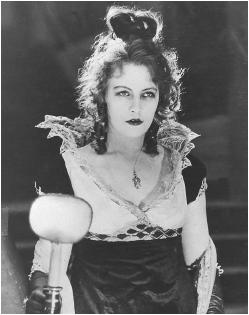GÖsta Berlings Saga - Film (Movie) Plot and Review
(The Story of Gösta Berling)
Sweden, 1923
Director: Mauritz Stiller
Production: Svensk Filmindustri; black and white, 35mm, silent, shown in two parts; running time: 137 minutes; length: first part-2346 meters, second part-2189 meters, eventually edited by Stiller down to about current length. Released 10 and 17 March, 1924. Re-released 1933–1934 in a re-edited version by Ragner Hylten-Cavallius, with sound. Filmed fall 1923 in Sweden.
Scenario: Mauritz Stiller and Ragner Hyltén-Cavillius, from the novel by Selma Lagerlöf; photography: Julius Jaenzon; art director: Wilhelm Bryde.
Cast: Lars Hanson ( Gösta Berling ); Gerda Lundequist-Dahlstrom ( Majorskan Samzelius ); Otto Elg-Lundgren ( Major Semzelius ); Sixten Melmerfelt ( Melchior Sinclaire ); Karin Swanstrom ( Gustafva Sinclaire ); Jenny Hasselqvist ( Marianne Sinclaire ); Ellen Cedarstrom ( Countess Martha Dohna ); Mona Martenson ( Countess Ebba Dohna ); Torsten Hammeren ( Count Hendrick Dohna ); Greta Garbo ( Countess Elizabeth Dohna ).

Publications
Books:
Idestam-Almquist, Bengt, Den Svenska Filmens Drama: Sjöstrom och Stiller , Stockholm, 1938.
Hardy, Forsyth, Scandinavian Film , London, 1951.
Idestam-Almquist, Bengt, Classics of the Swedish Cinema , Stockholm, 1952.
Bainbridge, John, Garbo , New York, 1955.
Waldenkranz, Rune, Swedish Cinema , Stockholm, 1959.
Beranger, Jean, La Grande Aventure du Cinema Suédois , Paris, 1960.
Conway, Michael, The Films of Greta Garbo , New York, 1963.
Cowie, Peter, Swedish Cinema , London, 1966.
Pensel, Hans, Seastrom and Stiller in Hollywood , New York, 1969.
Articles:
Potamkin, M. C., "The Golden Age of Scandinavian Film," in Cinema (London), September 1930.
Verdone, Mario, "Stiller," in Cinema (Milan), no. 126, 1954.
Idestam-Almquist, Bengt, "The Man Who Found Garbo," in Films and Filming (London), August 1956.
Gronowicz, A., "Greta Garbo and My Book," in Contemporary Review (London), December 1960.
Robertson, Jo Anne, "Mauritz Stiller," in Monthly Film Bulletin (London), December 1977.
Werner, G., "Svenska giganter," in Filmrutan (Stockholm), no. 3, 1981.
Paavolainen, Olavi, "Kaski mestaria - kaski vastakohtaa," in Filmihullu (Helsinki), no. 5, 1992.
Cristalli, P., "How Little You Know About Love," in Cinegrafie (Ancona), vol. 6, no. 10, 1997.
* * *
Gösta Berlings Saga is regarded by many as Sweden's Gone With the Wind . With an epic sweep, episodic structure, and numerous characters, it evokes 19th-century Swedish life and is imbued with a lyricism and vibrancy which places its director Mauritz Stiller among the masters of silent film. The film represents both the pinnacle and the swan song of the "golden age" of Swedish cinema— 1913–24. With its plot centering on the search for redemption by Gösta Berling, the defrocked priest, and the several women who disastrously fall in love with him, it numbers, along with Griffith's Intolerance , among the earliest important films of social protest and one of the masterpieces of silent cinema.
Stiller was a flamboyant dandy whose early reputation was built on sophisticated comedies exhibiting visual dexterity and artful editing. In 1919, he directed what is generally regarded as his foremost masterpiece— Sir Arne's Treasure ( The Three Who Were Doomed ), based on a novel by the popular Nobel Prize-winning Selma Lagerlöf. He directed the De Mille-like sex comedy Erotikon and then returned to adapting Lagerlöf's novels with Gunnar Hede's Saga and finally Gösta Berlings Saga .
Gösta Berlings Saga was a formidable undertaking which encompassed many characters and themes, required elaborate sets and costumes and resulted in a four-hour production shown in two parts on consecutive evenings. Stiller eventually conceded this impracticality and edited the film to 137 minutes. His editing, while judiciously shortening many scenes rather than eliminating them, nonetheless imposed a disjunction which ultimately mars the continuity. Despite this shortcoming, Gösta Berlings Saga remains a remarkable evocation of life among the Swedish aristocracy and mirrors its repression and hypocrisy. The first half of the film is devoted to exposition and the introduction of the many characters while the second half is highlighted by the dramatic fire in Ekeby Hall, a flight from wolves by sleigh across a frozen lake, and the brilliant acting of the venerable Gerda Lundequist-Dahlstrom as the shamed mistress of the manor.
Stiller's directorial technique was displayed through an expressive visual lyricism, an artistic use of light contrasted with shadowy darker hues and a picturesque depiction of the beauty and variety of the Swedish landscape. These elements are particularly evident in his photographing (with the masterful cinematographer Julius Jaenzon) of the then unknown Greta Garbo, who played Elizabeth. Stiller's scenes of Garbo picking flowers in the garden, carrying a lamp through the mansion hallways at night, and her first close-up in the sleigh scene capture the luminescence and radiance that made her the most unique female screen image of all time.
The success of Gösta Berlings Saga resulted in both Stiller and Garbo being hired by MGM in 1925. His three years in Hollywood destroyed Stiller and he returned to Sweden to die at the age of 45 in 1928. That same year Gösta Berlings Saga was released in the United States where a number of religious groups denounced it as "a glorified Elmer Gantry."
Lagerlöf disdained Stiller's interpretation of her novel, claiming he had seen "too many poor serials." For the most part Gösta Berlings Saga is remembered today as the film which introduced Garbo to the screen. However, it is a major work of the silent screen and as French critic Jean Beranger wrote: "If all but one Swedish silent film were to perish, this, probably, would be the one to save as the best witness of its period. All the charm, intelligence, profound human resonance and technical dexterity, here blend into an indissoluble bloc."
—Ronald Bowers
Comment about this article, ask questions, or add new information about this topic: